Markets
Rice Closed Higher Last Week and Was Led Higher by November
The harvest is almost over, and less Rice is on offer from producers. The export sales report was solid but not spectacular. The USDA reports showed little to get excited about either up or down in price. Yields are called average to below average in Texas and average so far in Arkansas as the harvest moves forward. The quality has been uneven with some crops affected by the extreme heat.

Wheat: Wheat markets closed lower last week in range trading and trends are sideways in all three markets. The war in Ukraine continues with Russia still bombing Ukrainian ports near the Black Sea and Danube River and has been having success. Ukraine moved last week to end shipping of grain from the Black Sea in response but then denied that they had stopped exporting through the Black Sea. Russia is still exporting and offering Wheat into the world market and is reporting that it is larger than originally thought. Ukraine and the EU countries are offering as well and are getting new business. Demand has been poor for US Wheat as Russia production looks strong, but exports are expected to increase for the rest of the marketing year. Weather forecasts call for drier weather for Australia and Argentina, with production losses now expected for both countries. There are reports of some showers in both countries to raise production estimates slightly but not enough to bring production close to averages. It has been too wet in southern Brazil and much of the Wheat grown there is expected to be feed grade instead o milling grade.
Weekly Chicago Soft Red Winter Wheat Futures
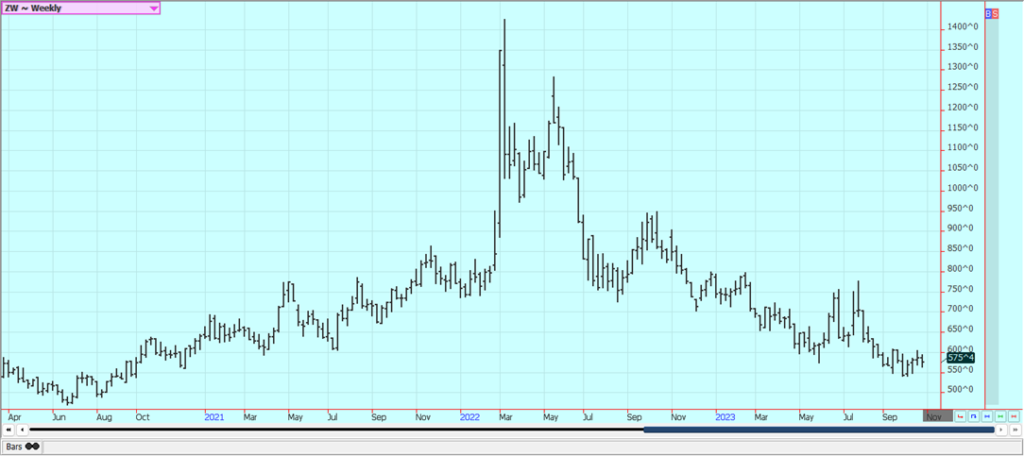
Weekly Chicago Hard Red Winter Wheat Futures
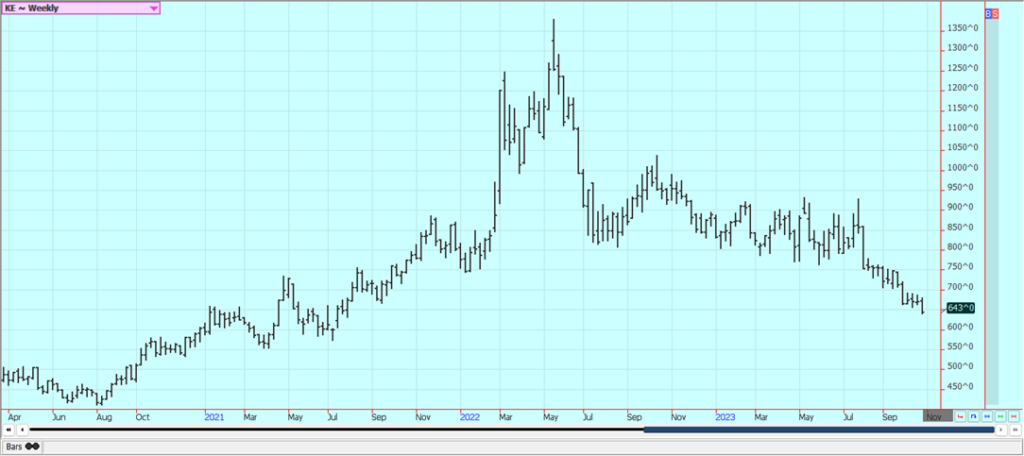
Weekly Minneapolis Hard Red Spring Wheat Futures
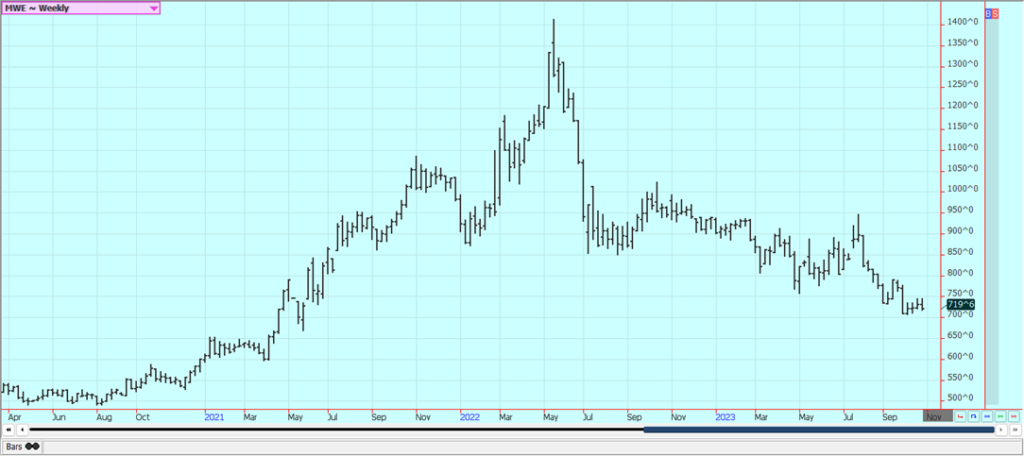
Corn: Corn closed lower last week on what appeared to be speculative selling tied to forecasts for an improvement in the South American weather and on clear weather in the US to promote active harvest progress. The dry weather in the central Midwest of the US is expected to return after some showers and rains last week. Trends are mixed in the market now on the daily charts. Oats closed higher. The US Corn harvest is continuing with good weather and yield reports showing good and bad results with no real trend evident. Farmers report no real sales of Corn as they wait for higher prices. Demand for US Corn in the world market has been very low and domestic demand has been weak due to reduced Cattle and other livestock production. Demand is increasing now. The Brazil Corn harvest is over so export prices for Corn from Brazil are relatively cheap and Brazil is getting the business. That could change in the coming year is the growing conditions deteriorate in Brazil as is possible in an El Nino year. It is already hot and dry in central and northern Brazil and in Argentina although some beneficial rains have been reported in Argentina and a few showers are reported in central and northern Brazil. Southern Brazil is too wet. Conditions are expected to continue to improve over the next couple of weeks as a few showers are expected for Argentina and central and northern Brazil. These will not be enough to save crops but could buy the crops a little time until better rains arrive, hopefully in the near future.
Weekly Corn Futures
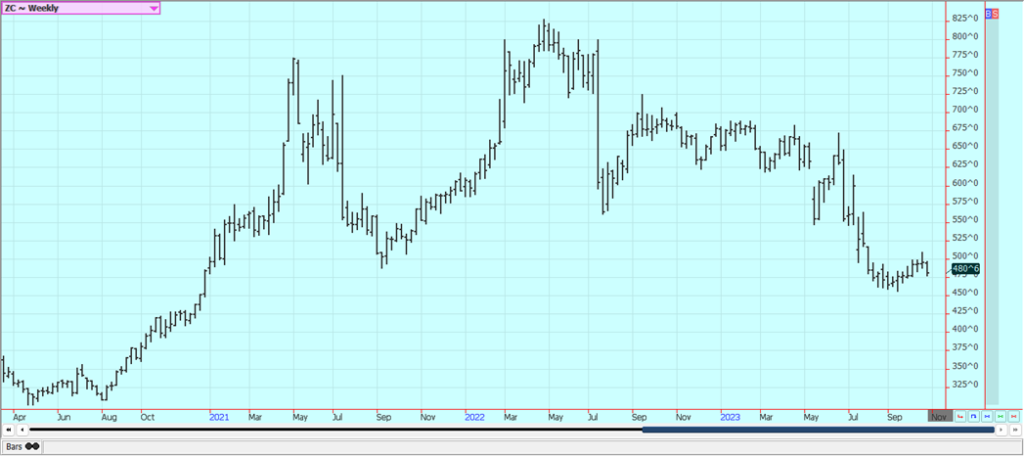
Weekly Oats Futures
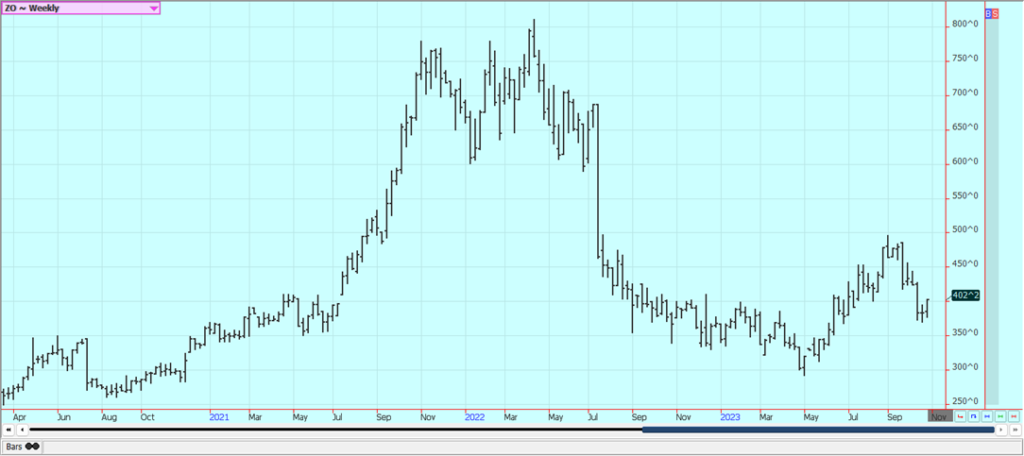
Soybeans and Soybean Meal: Soybeans and the products were higher on Friday and all but Soybean Oil were higher for the week. The weekly export sales report showed the highest sales for the marketing year, but the trade was more concerned about the improving weather forecasts for South America. Brazil remains mostly hot and dry in northern areas and too wet in southern areas. Some showers are in the forecast for northern Brazil. Argentina is also dry but has started to get some showers and rain. Yield results for the US new crop show that production and yields are above and below APH data with no real trend showing just yet. The data has been called disappointing to traders as production appears to be less than expected so far this crop year. Showers an rains are in the forecast for the rest of the week so harvest progress will be slower. Ideas are that the top end of the yield potential is gone and severe damage is becoming possible in some areas. Brazil is still selling a lot of Soybeans to China and other countries and reports indicate that the availability of Brazil Soybeans might be ramping down. The US sales to China have ramped up in the last month.
Weekly Chicago Soybeans Futures
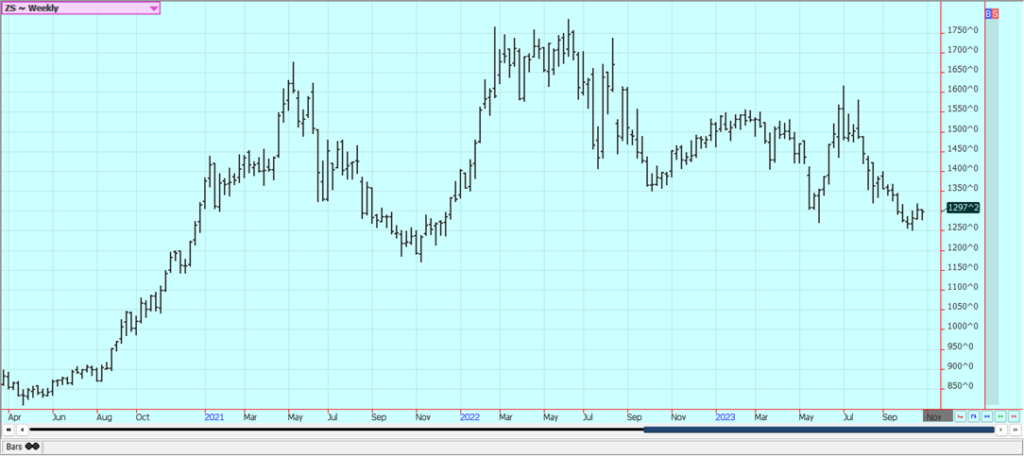
Weekly Chicago Soybean Meal Futures
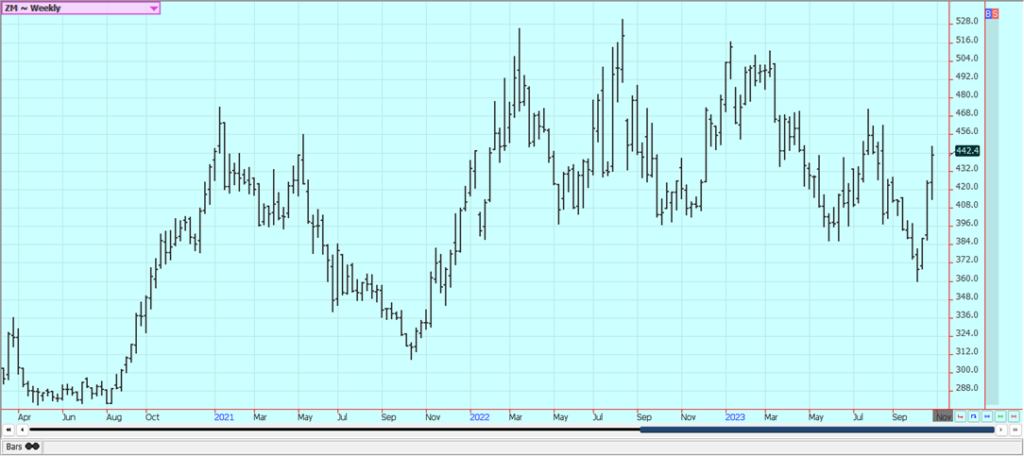
Rice: Rice closed higher last week and was led higher by November on what appeared to be commercial buying. The harvest is almost over and less Rice is on offer from producers. The export sales report was solid but not spectacular. The USDA reports showed little to get excited about either up or down in price. Yields are called average to below average in Texas and average so far in Arkansas as the harvest moves forward. The quality has been uneven with some crops affected by the extreme heat seen during the growing season. India will not allow Rice exports except for Basmati for now because of bad weather in some production areas. They have imposed export taxes of 20% on sales to keep the Rice in the country.
Weekly Chicago Rice Futures
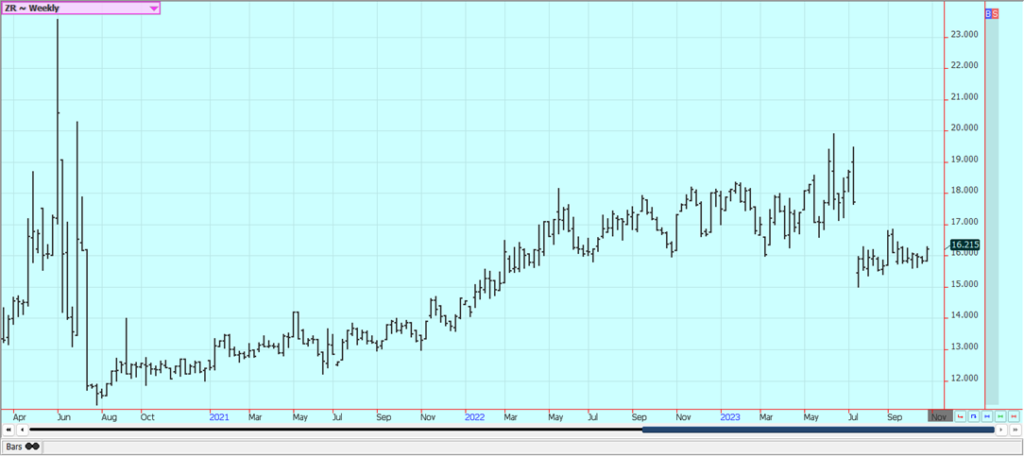
Palm Oil and Vegetable Oils: Palm Oil was lower last week despite speculative buying and stronger demand indications from India and China. Some say the market still needs to see less production coming. Traders still think that El Nino will cause big production problems down the road and are holding out hopes for rallies in the future, but supplies appear to be very strong for now. Trends are mixed on the daily charts. Canola closed lower last week along with the price action in Chicago and trends are down on the weekly charts but mixed on the daily charts in this market. Current price action implies that the market is trying to form, a low. Most were paying attention to improving weather forecasts for South America. Harvest has been active.
Weekly Malaysian Palm Oil Futures
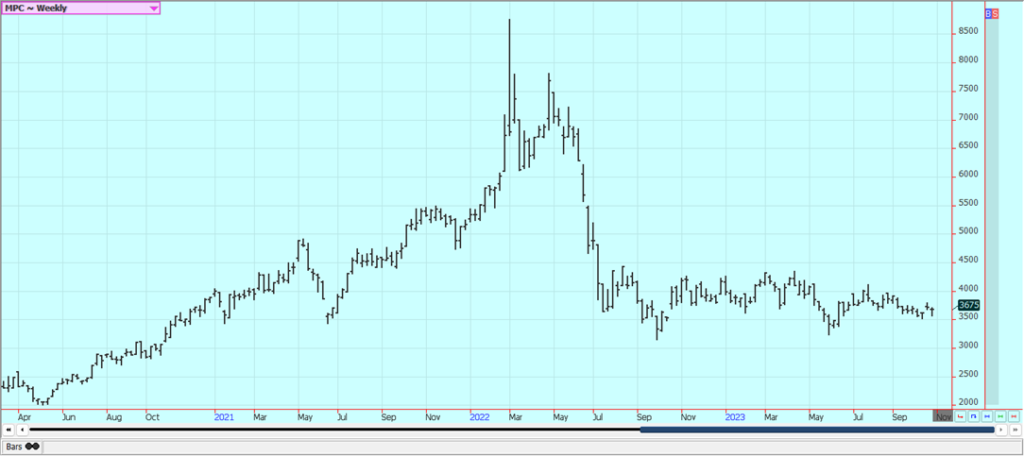
Weekly Chicago Soybean Oil Futures
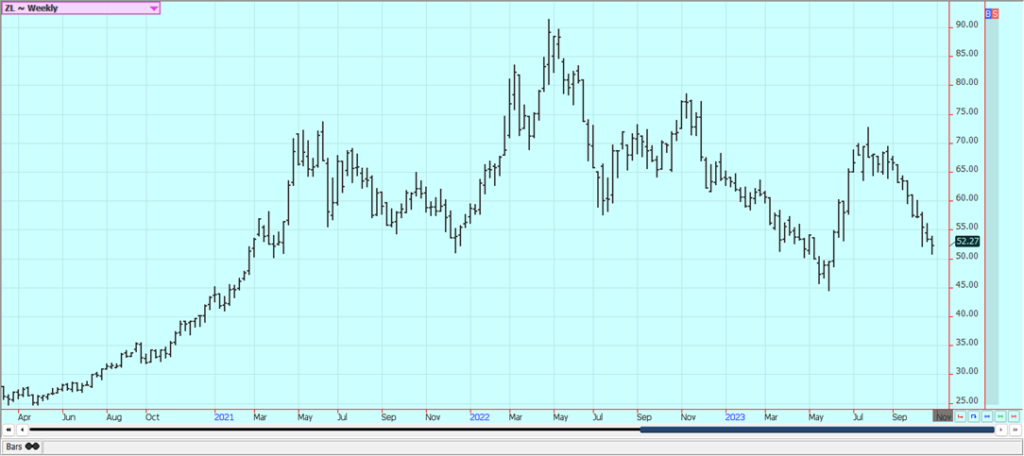
Weekly Canola Futures:
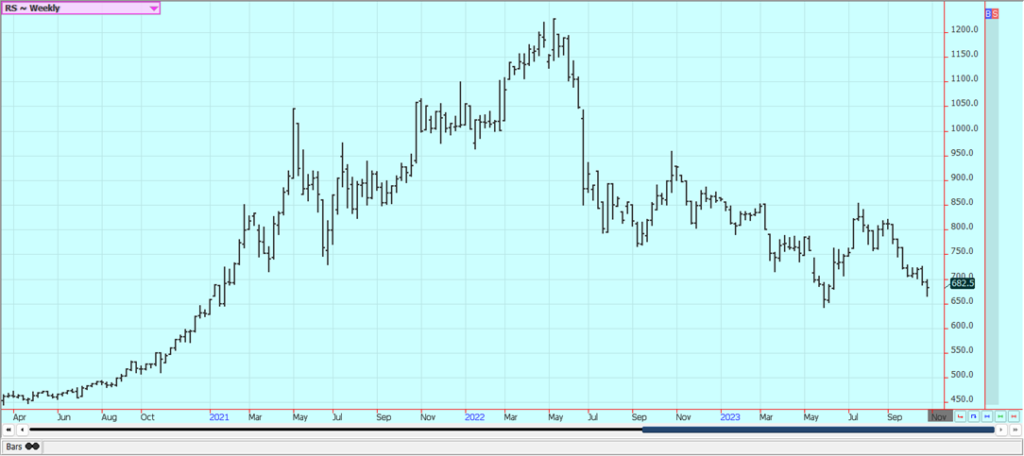
Cotton: Cotton closed higher last week on stronger-than-expected weekly export sales. Trends are starting to turn up on the daily charts. Sales for the current crop ear were about 185,000 bales and were much improved over the last few weeks. Macroeconomic data for the US was very strong as well. Ideas are that the US could be headed into a recession and cause demand to be soft. Prices are supported by ideas of tight supplies here in the US and around the world. There are still many concerns about demand from China and the rest of Asia due to the slow economic return of China in the world market. There are production concerns about Australian and Indian Cotton as both countries are likely to suffer the effects of El Nino starting this Fall.
Weekly US Cotton Futures
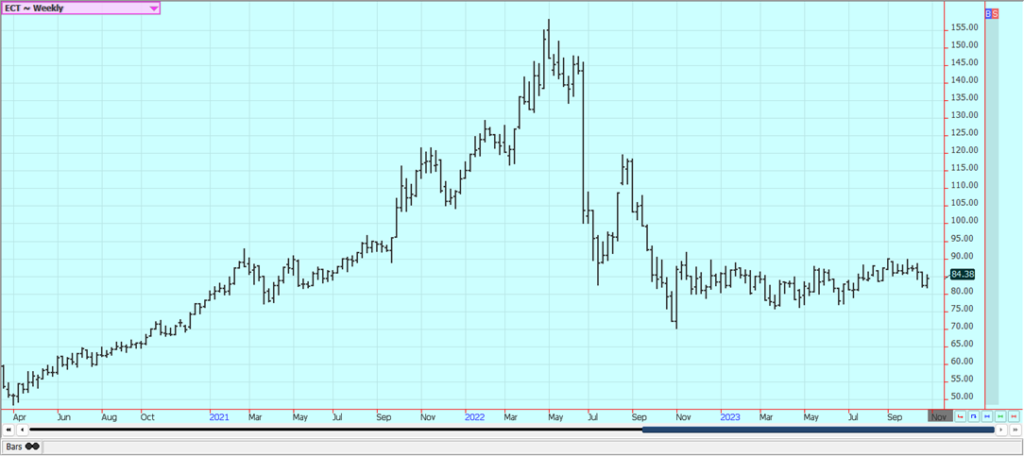
Frozen Concentrated Orange Juice and Citrus: FCOJ closed higher again last week on follow-through buying, and the trends on the daily charts are up. Reports of short supplies in Florida and Brazil are around. Futures are also being supported by forecasts for an above-average hurricane season that could bring a storm to damage the trees once again. Historically low estimates of production due in part to the hurricanes and in part to the greening disease that has hurt production, but conditions are significantly better now with scattered showers and moderate temperatures. The Florida Movement and Pack report showed that inventories are 44% less than last year.
Weekly FCOJ Futures
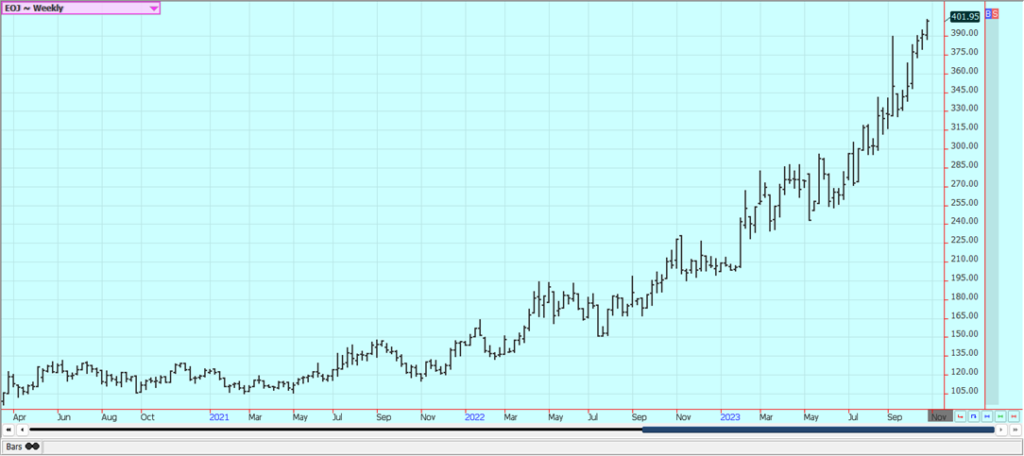
Coffee: New York and London closed a little lower last week, and trends are sideways in both markets. Light rains are now being reported in central and southern growing areas of Brazil and conditions are called good. Demand for Robusta and lower quality Arabicas remains strong. The lack of offers from Asia, mostly from Vietnam but also Indonesia remains a main feature of the market, but the offers are starting to improve with the Vietnam harvest progressing and the US Dollar moving higher. Offers from Brazil and other countries in Latin America should be increasing but prices are considered a little cheap to create much selling interest from producers and the differentials offered have been very high. These are moderating as the new harvest comes to the market.
Weekly New York Arabica Coffee Futures
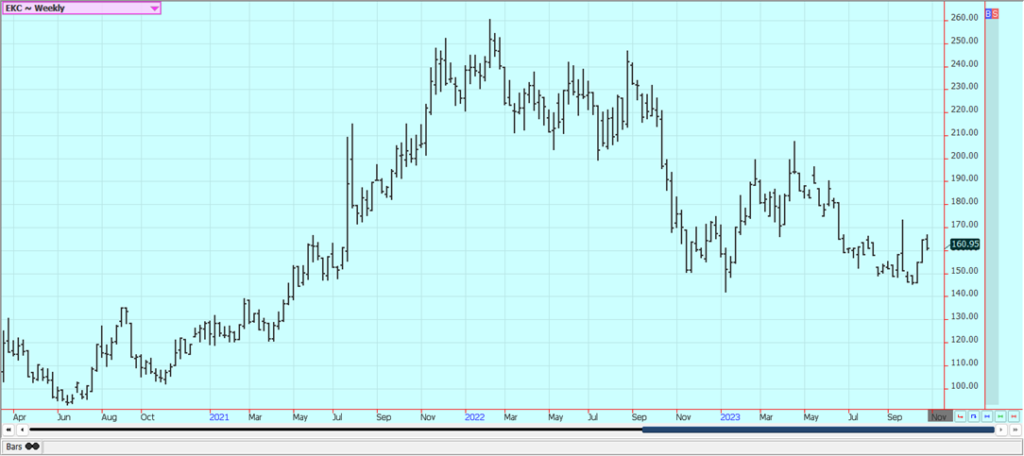
Weekly London Robusta Coffee Futures
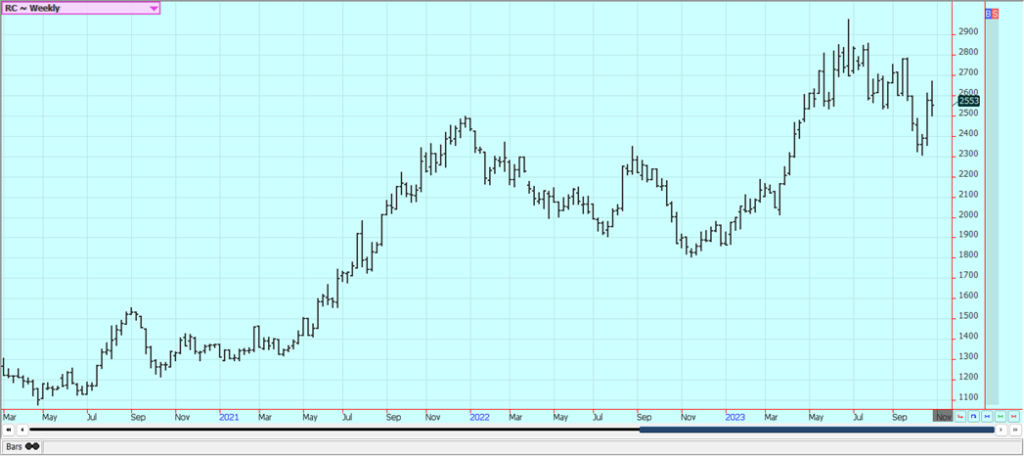
Sugar: New York and London closed higher last week and futures are trying to penetrate the previous highs on the weekly charts. Stronger Crude Oil prices promoted the refining for ethanol rather than Sugar. The market is still short of Sugar. There are still forecasts for and reports of rain in Brazil after a spell of very hot and dry conditions and this has delayed the loading of ships. The market continues to see stressful conditions in Asian production areas. The Brail rains is underway now, but showers have been light and scattered. The Asian dryness is still the main feature. Many growing areas in India have been dry, and exports have indicated that production has suffered. The government there now says it will have more than enough production for the domestic demand but will limit exports to help control inflation. There are also worries about the Thai and Indian production potential due to El Nino. Offers from Brazil are still active but other origins are still not offering, and demand is still strong. Brazil ports are very congested so shipment of Sugar has been slower. Mexico is hot and dry and there are increasing concerns about production there.
Weekly New York World Raw Sugar Futures
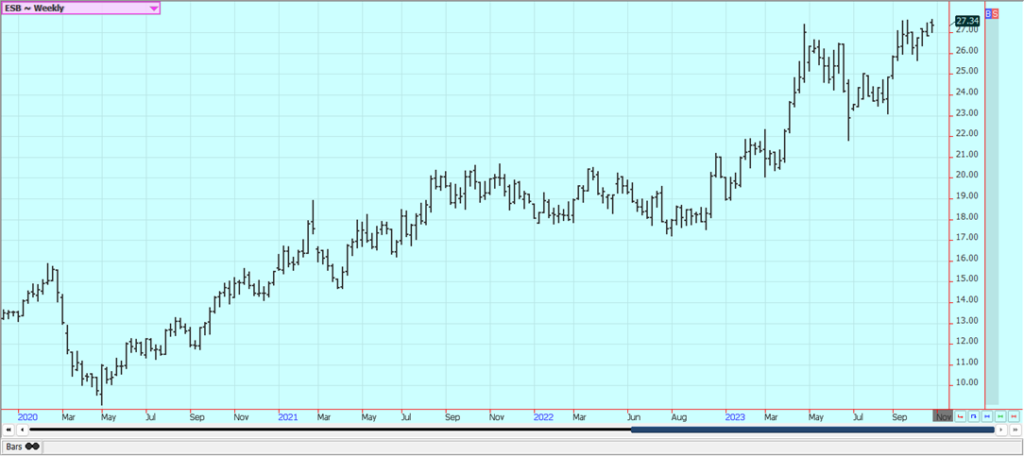
Weekly London White Sugar Futures
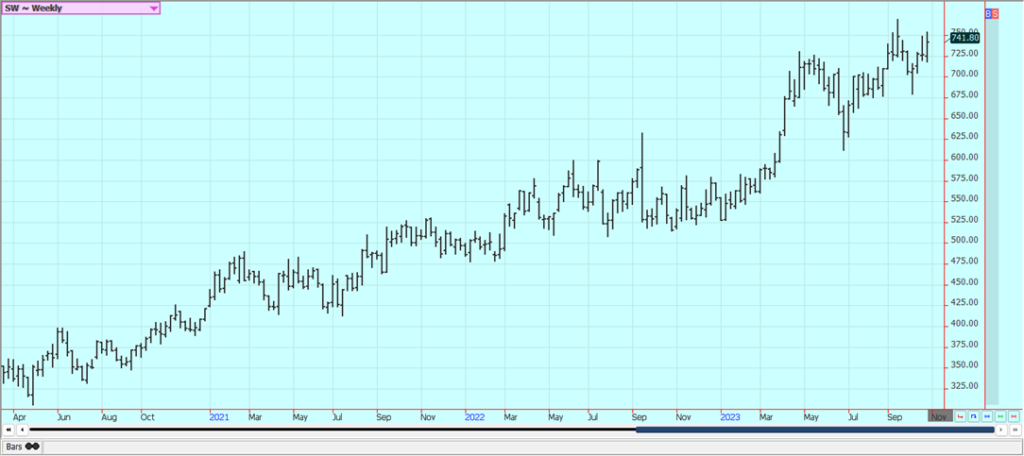
Cocoa: New York and London closed higher last week, and at new highs on the weekly charts. The trends are still up in both markets. The EU grind data was stronger than expected and was down 0.9% from last year. The North American grind data was weaker by 17.9%. Cocoa arrivals at Ivory Coast ports dropped 16.2% for the marketing year when compared to last year. The main crop harvest comes into focus and as farmers in West Africa report that many areas have too much rain that has caused harvest delays and could lead to disease. Ideas of tight supplies remain based on more reports of reduced arrivals in Ivory Coast and Ghana continue, Midcrop production ideas are lower now with diseases reported in the trees due to too much rain that could also affect the main crop production.
Weekly New York Cocoa Futures
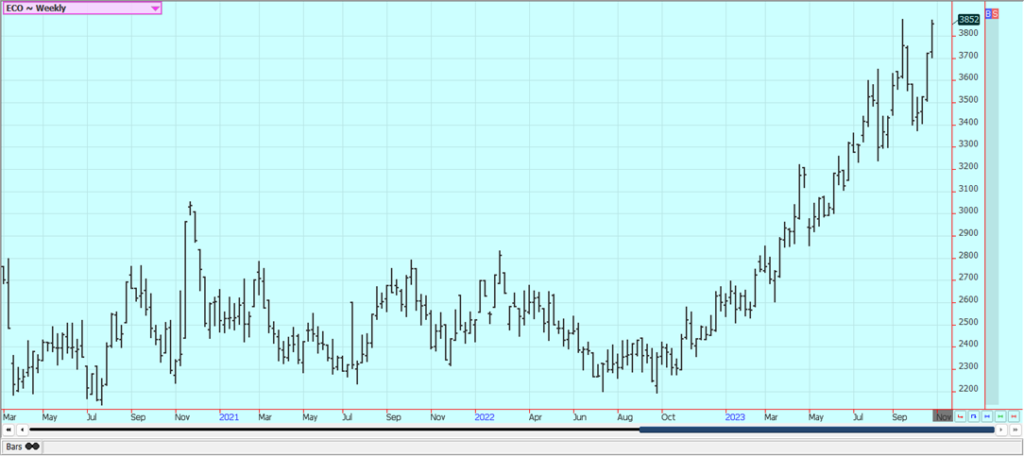
Weekly London Cocoa Futures
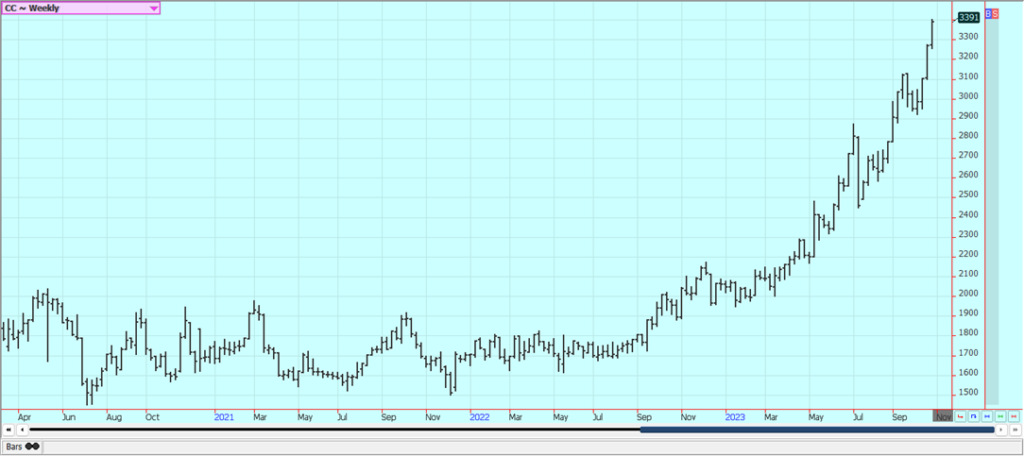
__
(Featured image by Luigi Pozzoli via Unsplash)
DISCLAIMER: This article was written by a third party contributor and does not reflect the opinion of Born2Invest, its management, staff or its associates. Please review our disclaimer for more information.
This article may include forward-looking statements. These forward-looking statements generally are identified by the words “believe,” “project,” “estimate,” “become,” “plan,” “will,” and similar expressions. These forward-looking statements involve known and unknown risks as well as uncertainties, including those discussed in the following cautionary statements and elsewhere in this article and on this site. Although the Company may believe that its expectations are based on reasonable assumptions, the actual results that the Company may achieve may differ materially from any forward-looking statements, which reflect the opinions of the management of the Company only as of the date hereof. Additionally, please make sure to read these important disclosures.
Futures and options trading involves substantial risk of loss and may not be suitable for everyone. The valuation of futures and options may fluctuate and as a result, clients may lose more than their original investment. In no event should the content of this website be construed as an express or implied promise, guarantee, or implication by or from The PRICE Futures Group, Inc. that you will profit or that losses can or will be limited whatsoever. Past performance is not indicative of future results. Information provided on this report is intended solely for informative purpose and is obtained from sources believed to be reliable. No guarantee of any kind is implied or possible where projections of future conditions are attempted. The leverage created by trading on margin can work against you as well as for you, and losses can exceed your entire investment. Before opening an account and trading, you should seek advice from your advisors as appropriate to ensure that you understand the risks and can withstand the losses.

-

 Markets1 week ago
Markets1 week agoMixed Market Trends as Global Coffee Growing Conditions Improve
-

 Fintech6 days ago
Fintech6 days agoPayPal Under Fire: Excessive Data Collection and Privacy Concerns in Advertising
-

 Biotech2 weeks ago
Biotech2 weeks agoJohnson & Johnson’s Tecvayli Combo Shows Breakthrough Results in Multiple Myeloma
-

 Africa1 day ago
Africa1 day agoMorocco’s Rising Country Risk Profile Boosts Investor Confidence
























